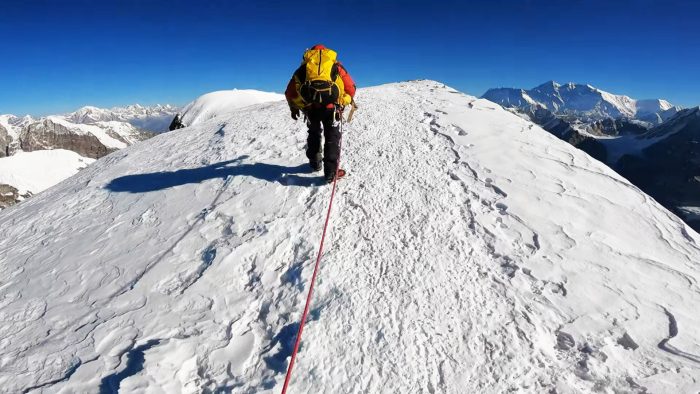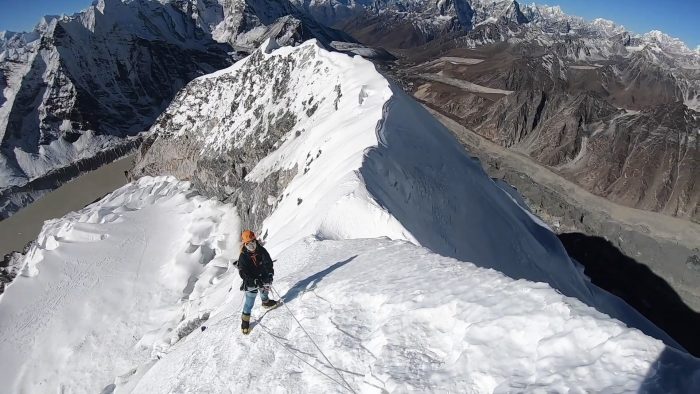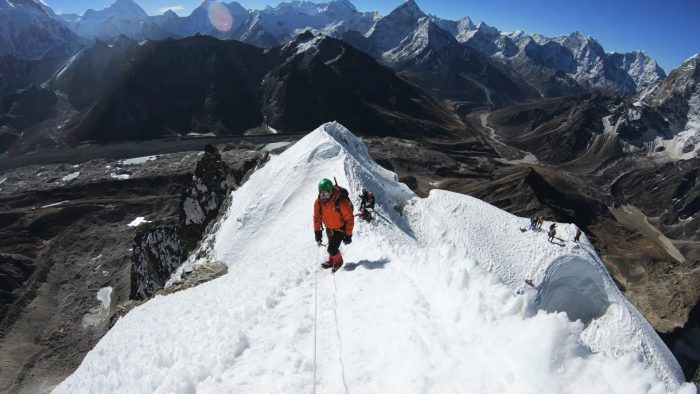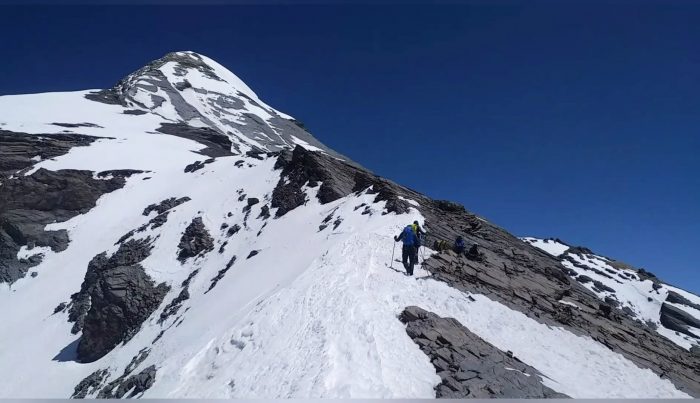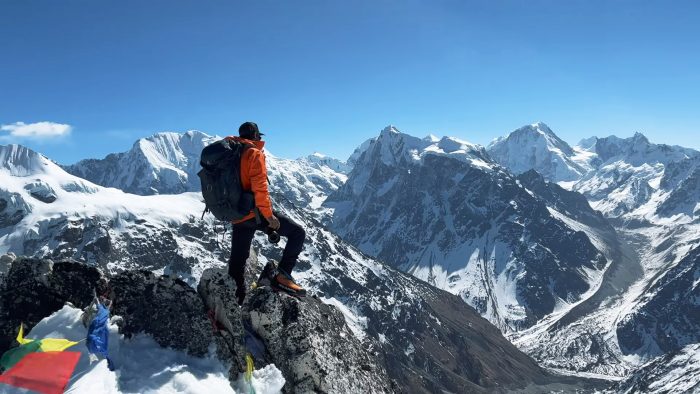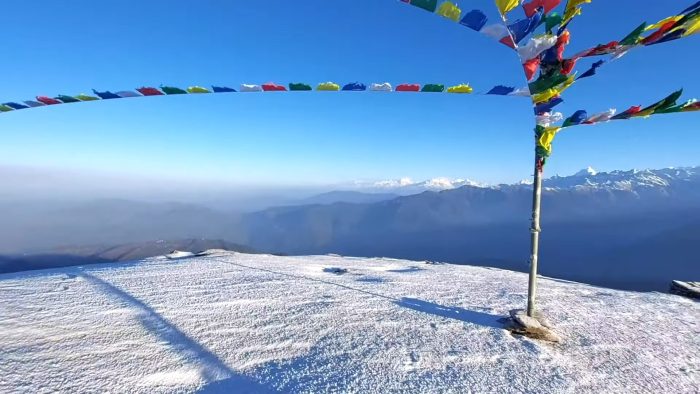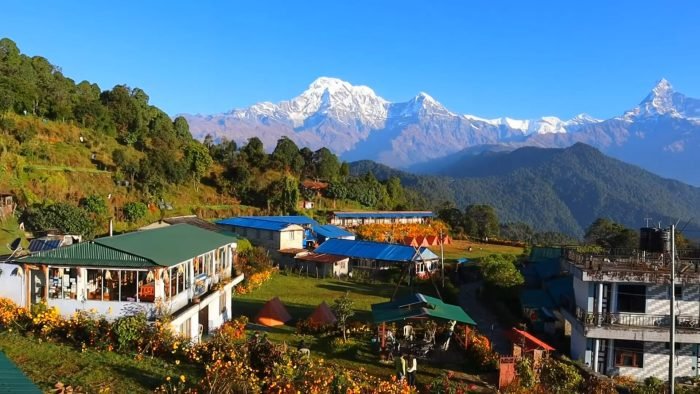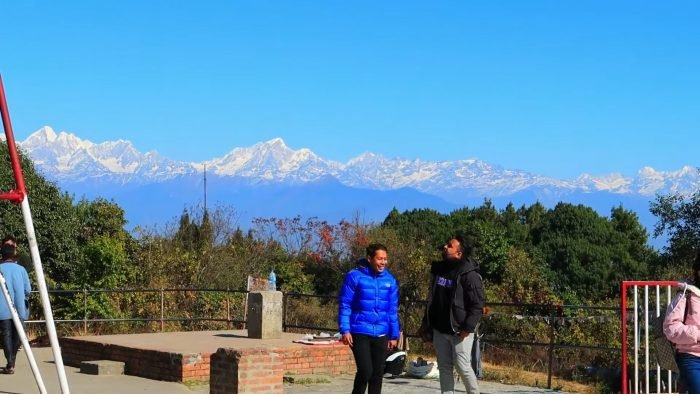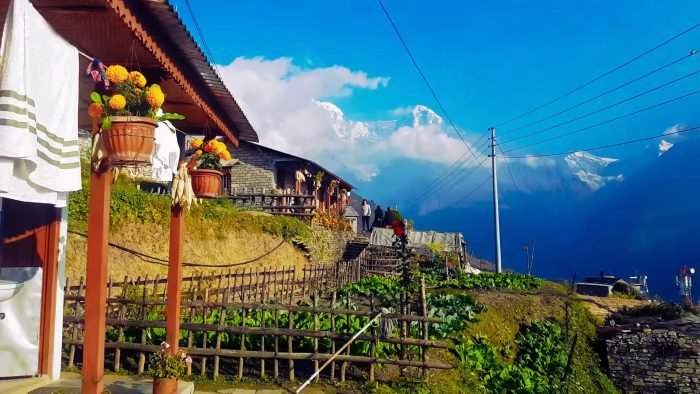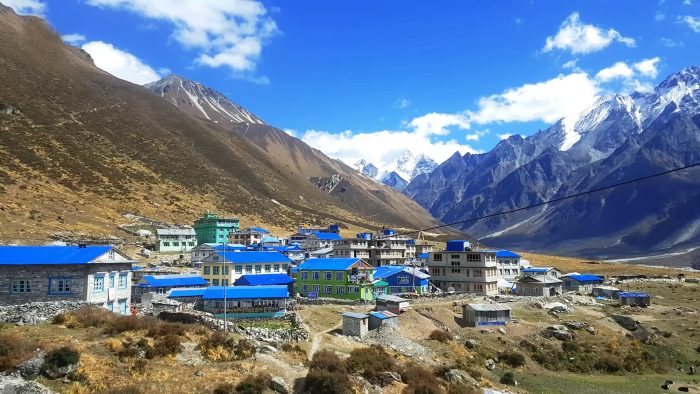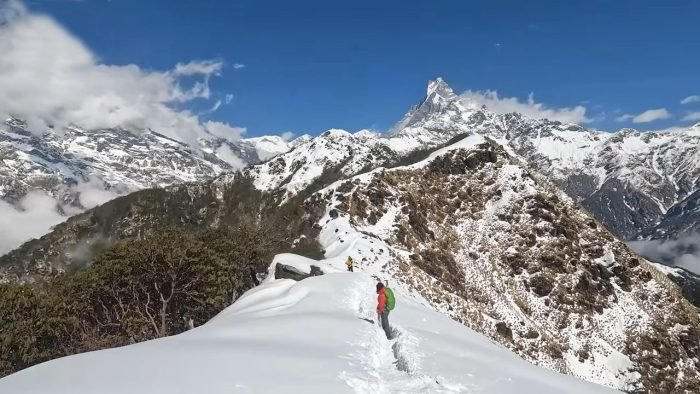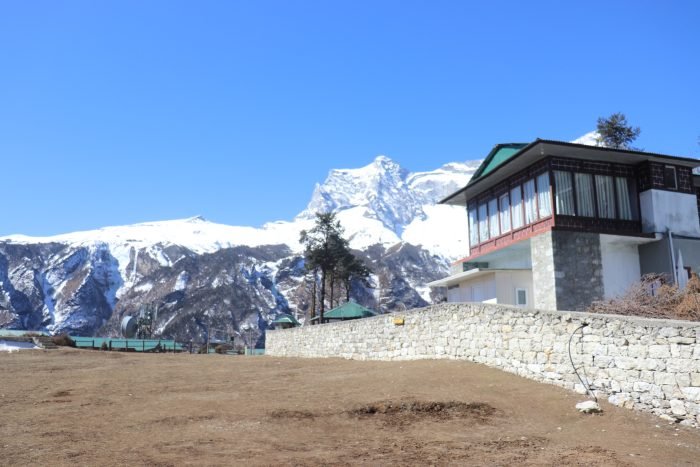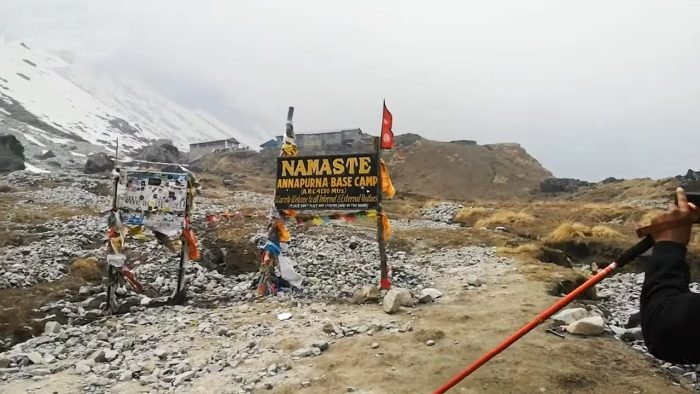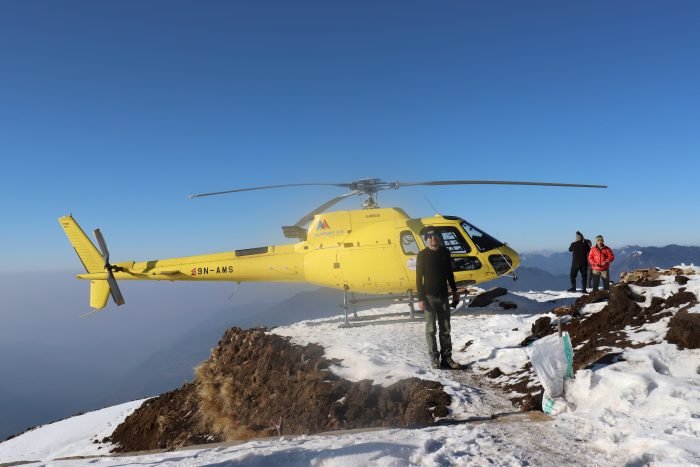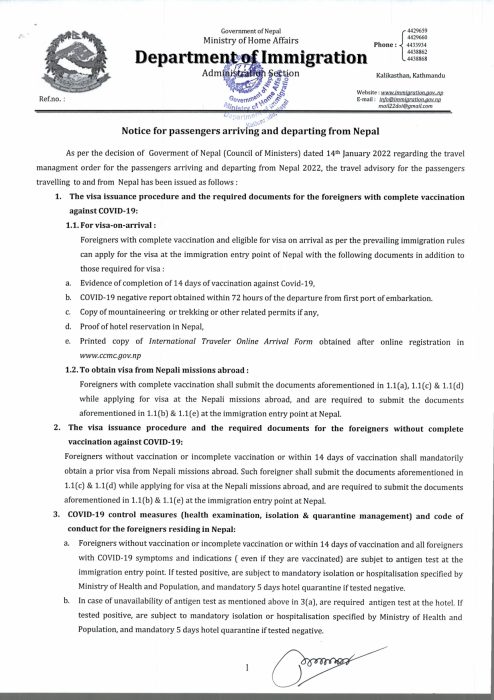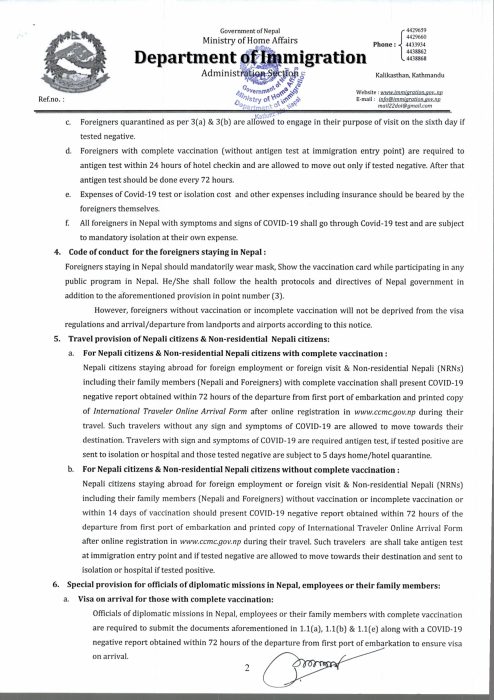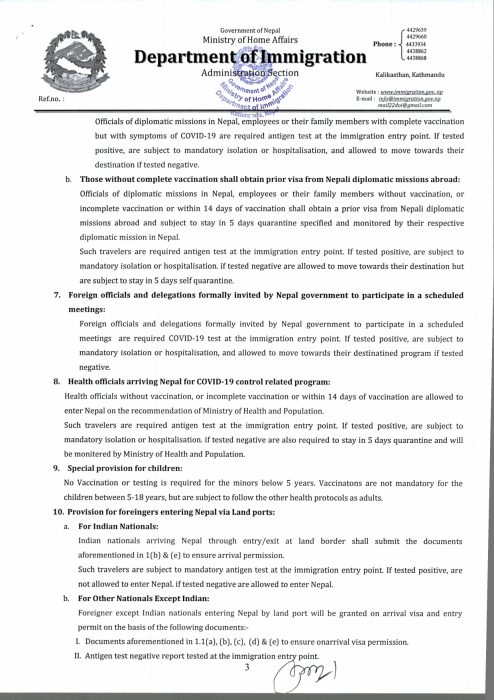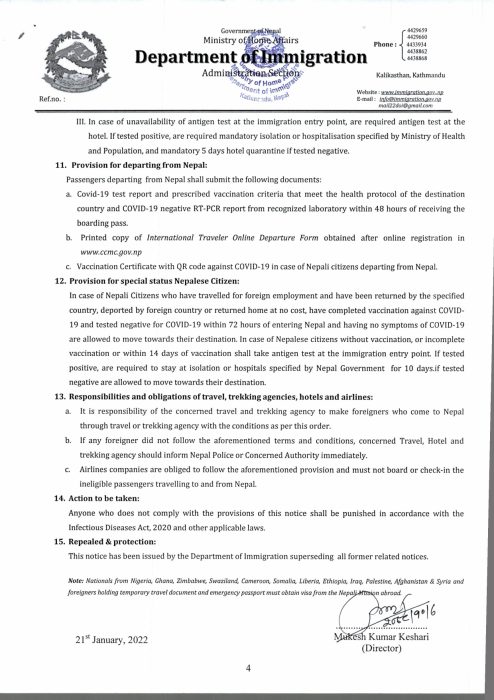Top 10 Best Treks in Nepal
If you are planning Nepal trekking then, the top 10 Best Treks in Nepal article is for you. Yes, if you are coming to Nepal trekking for the first time, then you are at the right place. We hope you will get the answer to your curiosity about trekking in Nepal. The top 10 Best Treks in Nepal article has been prepared based on the popularity among trekkers.
Nepal is an ideal destination for adventure travelers. There are many options for tourist activities in Nepal such as trekking, tours, day hiking, peak climbing, rafting, jungle safari, etc. But the first choice of most tourists is trekking. You can find easy treks to breathtaking treks in the same country. Therefore, now Nepal has become a popular trekking destination in the world.
Nepal is a land of mountains, and these mountains lead trekking lovers to Nepal. Nepal is the destination of about 300000 trekkers every year. But those trekkers are facing difficulty in choosing the best trekking. You are also facing the problem of which trekking to choose in Nepal. So, to make it easy for everyone to choose the best trip, we have presented an article on the Top 10 Best Treks in Nepal.
Nepal offers many types of trekking trip
Among the top 10 Best Treks in Nepal presented below, we can’t say which one is the best trekking for you. Your needs and purpose for trekking may be different from other trekkers. This list includes many types of trekking like a long day, short day, tough, easy, high altitude, low altitude, etc. So, you can choose trekking that suits you according to your needs.
Nepal offers you more than 100 trekking packages. So first of all, make sure what kind of trekking you are looking for in Nepal. If you determine your needs and purpose of trekking, it will be easy to choose the best trekking from the given list.
You may like: the 5 best climbing peaks in Nepal
Although the internet has made it easy to find your favorite trek, different websites may have different suggestions about the best treks in Nepal. Likewise, hundreds of local trekking companies operating in the tourist hub of Thamel also give you suggestions for the best treks in Nepal. But they also have different opinions about the best treks in Nepal. So, first, research the best one trekking according to your needs from different mediums. Then you can choose one of the best trekking companies for more information about the trek you have chosen.
Before choosing a trip, you should be clear on some relevant aspects. If you are clear about these aspects then surely choosing trekking will be easy for you. Let’s take a look at some relevant aspects of trekking.
Relevant Aspects:-
*What level of trekking are you looking for – easy, moderate, or difficult?
*How much time do you have in Nepal for trekking? (From 2 days of trekking to more than 1-month trekking packages are available in Nepal).
*How many hours can you walk in the Himalayas every day on average? (An average of 3-4 hours of walking a day is sufficient for some trekking, while for some trekking you have to walk for 7-8 hours)
*Looking for a remote trekking destination or an easily accessible trekking spot nearby?
*How much budget are you planning to spend on Nepal trekking? (Simple basic trekking packages to luxury trekking packages are available)
*What kind of trekking do you want to do, a hard camping trek or a simple teahouse trek? (Teahouse trek is a budget trek while the camping trek is a comparatively expensive trek)
*In which season are you thinking of trekking? (Some high mountain treks are not recommended during winter and monsoon season)
*Are you a solo trekker or with someone? (Some trekking areas are restricted where at least two people are required to get a trekking permit.)
*Do you want to trek through a company or without a company? (In some restricted areas, you can do trekking only through a local trekking company.
*Looking for low-altitude trekking or high-altitude trekking?
Once you are clear on the above-mentioned aspects, it will be easy for you to choose the right trekking. Let’s zoom out on the list of the top 10 best treks in Nepal which are sorted by popularity and most trekked.
1. Everest Base Camp Trek
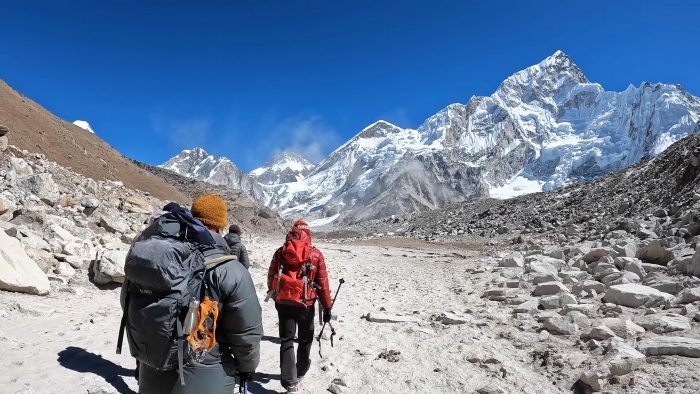
Trip Highlights
Duration: 14 Days
Region: Everest
Maximum Elevation: 5,545m
Accommodation: Tea House
Grade: Moderate
Restricted Permits: No
Best Seasons: Mar-May, Sep-Nov
Yes, the most famous and best trek in Nepal is the Everest base camp trek. This trekking fulfills the desire to see the world’s highest peak up close. Which hiker doesn’t have the desire to see Mount Everest up close? Of course, everyone has. That’s why the Everest trek is the first choice of many trekkers in Nepal. This journey takes you to the lap of Mount Everest above 5,000 meters, where your dreams come true.
Everest base camp is one of the most beautiful treks in the high mountains of Nepal. About 30,000 tourists trek in this region every year and most of them opt for the Everest Base Camp trek. Everest Base Camp Trekking is one of the top three trekking destinations in the world with some of the best mountain scenery in the world.
This trek is in the Khumbu region of Nepal which is also the most famous trekking region of Nepal. Mount Everest is located in Everest National Park which is the highest national park in the world. This national park is a UNESCO World Heritage Site. This trek is also popular for Khumbu Himalayan Glacier, Khumbu Icefall, and Sherpa culture.
Enjoy Mountains Scene
The Everest base camp trek allows you to see many amazing high mountains. During the trek, you can enjoy a panoramic view of mountains above 8,000 meters such as Mount Everest (8,848m), Mount Lhotse (8,516m), Makalu (8,481m), and Cho-Yo (8,201m). The beautiful scenery of the Himalayas will not leave you throughout the trip. The magnificent mountains, stunning waterfalls, and rhododendron forests will give you a unique and pleasant feeling.
You will pass many beautiful Sherpa settlements on the way to the base camp. The Sherpa people are the local inhabitants of the Everest region and you know that the Sherpas are world famous for mountain climbing. This trip provides an opportunity to interact with the locals of the Everest region. It is also an opportunity to learn about the culture, traditions, and lifestyle of the Sherpas.
On the way, you will find many prayer flags, monasteries, and suspension bridges which add more excitement to the journey. While trekking you will get away from the busy city life and luxuries and enjoy the natural beauty. The Everest base camp trek will be one of the best high mountain treks you will do in your lifetime.
Visit also: Everest Base Camp Helicopter Tour in just 4 hours, Itineary
Start Trek
On the first day of the trek, you will transfer from the hotel to the airport early in the morning. A short thrilling and scenic flight of 45 minutes will take you to Lukla Airport at an altitude of 2,846 meters. You will start trekking from Lukla Airport to Phakding Village (2,610m).
After Phakding your next destination will be Namche Bazaar (3,440m) which is the main and famous trading market of the Khumbu region. You will cross several suspension bridges along the northern bank of the Dudhkoshi River enjoying the scenic views. There will be an acclimatization day at Namche to avoid altitude sickness and acclimatize your body.
During your stay in Tengboche village, you can visit Tengboche Monastery. Tengboche Monastery at an altitude of 3,860 meters is the largest and most famous monastery in the Khumbu region. At Dingboche (4,410m) you will have gained a lot of altitudes so again another acclimatization day will be at Dingboche.
View of Mountains
From Dingboche, you will have a magnificent view of the mountains of Lhotse (8,516m), Makalu (8,485m), Cho Oyu (8,189m), Nuptse (7,861m), Ama Dablam (6,812m), Mera Peak (6,476m), Island Peak (6,189m), Lobuche Peak (6,119m), etc.
The trail takes you from Dingboche to Lobuche and then to Everest base camp. Enjoy incredible views of the world’s highest peak and other surrounding mountains at Everest Base Camp. Capture breathtaking views on camera for a lifetime memory. After some time, you will return to Gorak Shep by the same route. Gorak Shep is a beautiful village at an altitude of 5,140 meters surrounded by snow-capped mountains.
From Gorak Shep, you will hike up to Kalapatthar (5,545m). Kalapatthar is a famous place for sunrise. From here you can see amazing views of the sunrise over Mount Everest and other surrounding peaks. By the same route, you will reach Lukla and your trip will be complete.
If you are in good health, have normal trekking experience, and can walk for 6-7 hours a day without difficulty then you can complete the Everest Base Camp Trek. You don’t need any technical skills or training for this trek. But previous high-altitude trekking experiences or regular walking habits make the trip easier. The Everest Base Camp trek requires Khumbu Pasang Lhamu Rural Municipality Entrance Permit and Sagarmatha National Park Entry Permit.
Itinerary
1st Day: Fly Kathmandu to Lukla (2,840m) and start trek to Phakding (2,610m) – 4 to 5 hours walk.
2nd Day: Trek Phakding to Namche Bazaar (3,440m) – 6 to 7 hours walk.
3rd Day: Acclimatization and exploration day at Namche Bazar.
4th Day: Trek Namche Bazaar to Tengboche (3,860m) – 5 to 6 hours walk.
5th Day: Tengboche to Dingboche (4,410m) – 5 to 6 hours walk.
6th Day: Acclimatization and exploration day at Dingboche.
7th Day: Trek Dingboche to Lobuche (4,910m) – 5 to 6 hours walk.
8th Day: Trek Lobuche to Gorak Shep (5,160m). Excursion to Everest Base Camp (5,364m) and back to Gorak Shep – 8 to 9 hours walk.
9th Day: Excursion around Kalapatthar (5,545 m) and trek down to Pheriche (4,240m) – 6 to 7 hours walk.
10th Day: Pheriche to Phortse (3,810m) – 5 to 6 hours walk.
11th Day: Phortse to Namche (3,440m) – 5 to 6 hours walk.
12th Day: Namche to Phakding (2,610m) – 4 to 5 hours walk.
13th Day: Phakding to Lukla (2,840m) – 4 to 5 hours walk.
14th Day: Fly Lukla to Kathmandu – 45 minutes.
2. Annapurna Base Camp Trek
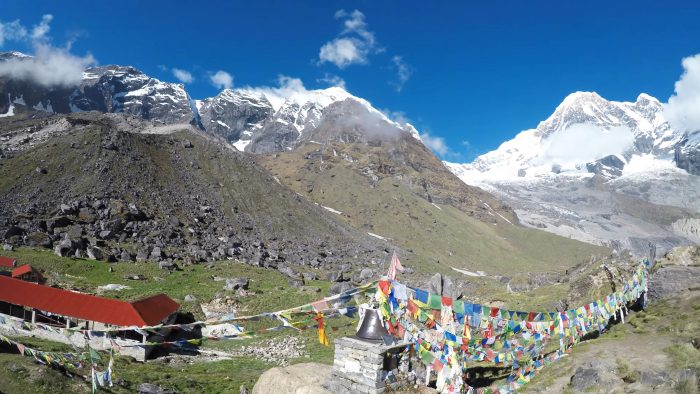
Trip Highlights
Duration: 14 Days
Region: Annapurna
Maximum Elevation: 4,130m
Accommodation: Tea House
Grade: Moderate
Restricted Permits: No
Best Seasons: Mar-May, Sep-Nov
Annapurna Base Camp Trek is another trek on the list of the top 10 best treks in Nepal. Located in the Annapurna region of Nepal, this trek is one of the most popular treks in Nepal. In short, Annapurna Base Camp Trek is also known as ABC Trek. Annapurna region is also the most trekked region after the Everest region.
Located at an altitude of 4,130 meters above sea level, Annapurna Base Camp is one of the most preferred trekking destinations in Nepal for many foreign and domestic trekkers. The ABC trek is also known as the Annapurna Sanctuary Trek as you walk inside the Annapurna Conservation Area.
View of Beautiful Mountains
The Annapurna Base Camp Trek offers a comprehensive exploration of the 50km Annapurna range’s most fascinating terrain. During the trek, you can see the breathtaking views of Annapurna (8,091m), Gangapurna (7,455m), Machhapuchhre (6,993m), Lamjung (6,983m), Hiunchuli (6,441m), Nilgiri South (6,839m) and many other magnificent peaks.
Apart from the natural scenery, many Gurung and Magar villages also offer an opportunity to experience their unique culture and traditions. The scenic view of preserved bamboo, alpine vegetation, and dense rhododendron forest inside the sanctuary will captivate you. The bamboo, alpine vegetation, and dense rhododendron forests along the trekking trail look especially beautiful in spring.
Although there are many trekking routes to reach the Annapurna base camp, generally the trek starts from Pokhara and ends in Pokhara. Some trekkers choose this route as an alternative to trekking Everest base camp trek. As this trek is easy compared to other high-altitude excursions, any fit person with a little determination can complete this trek.
Start Trek
Your journey will begin with a tourist bus from Kathmandu to Pokhara (approximately 6-7 hours). Pokhara is a beautiful tourist city that is also known as the city of lakes. After a short drive from Pokhara, you reach Nayapul and from there your trekking starts. The route leads through the beautiful Ulleri and Ghorepani villages to Poon Hill (3,193m).
If you are a sunrise lover then Poon Hill is for you. Poon Hill is the best viewpoint for sunrise from where you can see the sunrise over more than 32 Annapurna ranges including Dhaulagiri, Nilgiri, and Machhapuchhre (Fishtail) mountains. Poon Hill is also a famous place for photography so capture the beautiful sunrise view on your camera.
This trip is an adventure trip of natural beauty and Himalayan majesty that you probably don’t want to miss. Annapurna Base Camp Trek is a moderate-level trek requiring no prior trekking experience. However, prior trekking experience makes trekking easier. Teahouses are available for food and accommodation on this trekking trail. TIMS (Trekkers’ Information Management System) and ACAP (Annapurna Conservation Area Permit) permits are mandatory for trekking in this area.
Itinerary
1st Day: Drive Kathmandu to Pokhara (8,20m) – 7 to 8 hours.
2nd Day: Drive Pokhara to Nayapul (2 hours) and start trek to Ulleri (1,960m) – a 5 to 6 hours walk.
3rd Day: Ulleri to Ghorepani (2,860m) – 5 to 6 hours walk.
4th Day: Excursion to Poon Hill (3,193m) and trek to Tadapani (2,590m) – 7 to 8 hours walk.
5th Day: Tadapani to Chhomrong (2,340m) – 5 to 6 hours walk.
6th Day: Chhomrong to Doban (2,505m) – 6 to 7 hours walk.
7th Day: Doban to Deurali (3,100n) – 3 to 4 hours walk.
8th Day: Deurali to Annapurna Base Camp (4,130m) – 4 to 5 hours walk.
9th Day: Annapurna Base Camp to Bamboo (2,335m) – 6 to 7 hours walk.
10th Day: Bamboo to Jhinu Danda (1,610m) – 5 to 6 hours walk.
11th Day: Jhinu Danda to Landruk (1,565m) – 3 to 4 hours walk.
12th Day: Landruk to Dhampus (1,650m) – 6 to 7 hours walk.
13th Day: Dhampus to Phedi (2 to 3 hours walk) and drive to Pokhara (30 minutes).
14th Day: Drive Pokhara to Kathmandu – 7 to 8 hours.
3. Everest Three pass Trek
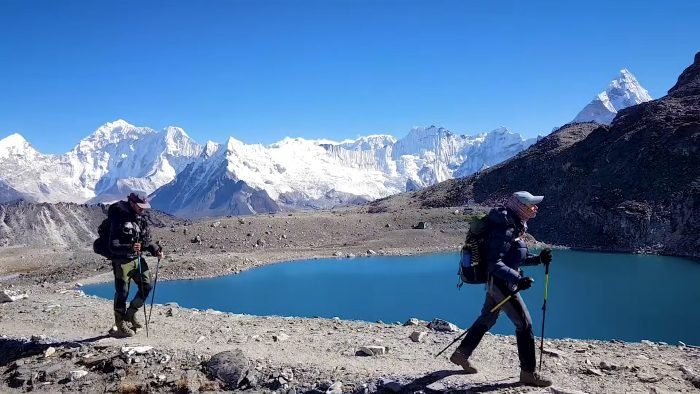
Trip Highlights
Duration: 18 Days
Region: Everest
Maximum Elevation: 5,545m
Accommodation: Tea House
Grade: Moderate to Strenuous
Restricted Permits: No
Best Seasons: Mar-May, Sep-Nov
Everest Three Pass Trek is another famous trek in the list of 10 best treks in Nepal. This adventure trip is a combination of the Everest base camp and the famous 3 high passes of the Everest region. Everest Three Pass Trek is a perfect trek for thrill seekers and adventurers in the Everest region of Nepal. Hence, this trek is an ideal choice for the true adventure seeker looking for challenging high mountain passes including Everest base camp.
Everest Three Pass Trek takes you to the high passes Renzo La Pass (5,360m), Cho-La Pass (5,420m), and Kongma-La Pass (5,535m), so this trek is also called Everest High Pass Trek. Apart from 3 high passes, this trip also takes you to the highest points of Gokyo Ri (5,357m), Kalapatthar (5,545m), and Everest Base Camp (5,364m).
This adventure trekking is a unique experience of mountain vistas and snow-capped mountain scenery. Experience the adventure of crossing three high passes in one trip in Nepal’s Everest region. This is one of the most enjoyable treks on the ice of the high pass which gives you a great view of the mountains and glaciers.
View of 4 Peaks above 8,000 meters
This trekking area is located in Sagarmatha National Park. Sagarmatha national park is the highest national park in the world and is a UNESCO World Heritage Site. Sagarmatha National Park covers an area of 1,148 square kilometers. The trek offers you a panoramic view of 4 peaks above 8,000m Mount Cho Oyu (8,201m), Mount Makalu (8,463m), Mount Lhotse (8,516m), and Mount Everest (8,848m).
During the trekking, you will enjoy a unique taste of the nature, culture, and traditions of the Everest region. It is also an opportunity to experience up close the culture, traditions, and lifestyle of the people of the Himalayan region. More than just a trek, the Everest Three Pass Trek is a great mountain trip that you will do in your lifetime.
This is a challenging trek so you need good physical fitness with previous trekking experience. This is a lodge trekking so you will find teahouses run by locals along the way. Teahouses are a type of small lodges that provide food and accommodation for trekkers.
Everest High passes trek requires Khumbu Pasang Lhamu Rural Municipality Entrance Permit and Sagarmatha National Park Entry Permit. For Khumbu Pasang Lhamu Rural Municipality Entrance Permit Rs. 2000 and Sagarmatha National Park Entry Permit Rs. 3000 you have to pay.
Itinerary
1st Day: Fly Kathmandu to Lukla (2,840m) and start trek to Phakding (2,610m) – 4 to 5 hours walk.
2nd Day: Phakding to Namche Bazaar (3,440m) – 6 to 7 hours walk.
3rd Day: Acclimatization and exploration day at Namche Bazar.
4th Day: Namche Bazaar to Tyangboche (3,860m) – 5 to 6 hours walk.
5th Day: Tyangboche to Dingboche (4,410m) – 5 to 6 hours walk.
6th Day: Dingboche to Chhukung (4,730m) – 3 to 4 hours walk.
7th Day: Chhukung to Kongma La Pass (5,535m) and Lobuche (4,910m) – 9 to 10 hours walk.
8th Day: Lobuche to Everest Base Camp (5,364m) and back to Gorak Shep (5,140m) – 8 to 9 hours walk.
9th Day: Excursion to Kala Patthar (5,545m) and trek down back to Dzongla – 7 to 8 hours walk.
10th Day: Dzongla to Thagnag Kharka (5,025m) via Cho La Pass (5,420m) – 8 to 9 hours walk.
11th Day: Thagnag Kharka to Gokyo (4,790m) – 4 to 5 hours walk.
12th Day: Excursion to Gokyo Ri (5,357m) and back to Gokyo – 5 to 6 hours walk.
13th Day: Gokyo to Lungden via Renjo La Pass (5,360m) – 8 to 9 hours walk.
14th Day: Lungden to Thame (3,820m) – 4 to 5 hours walk.
15th Day: Thame to Namche Bazaar (3,440m) – 5 to 6 hours walk.
16th Day: Namche to Phakding (2,610m) – 4 to 5 hours walk.
17th Day: Phakding to Lukla (2,840m) – 4 to 5 hours walk.
18th Day: Fly Lukla to Kathmandu – 45 minutes.
4. Ghorepani Poon Hill Trek
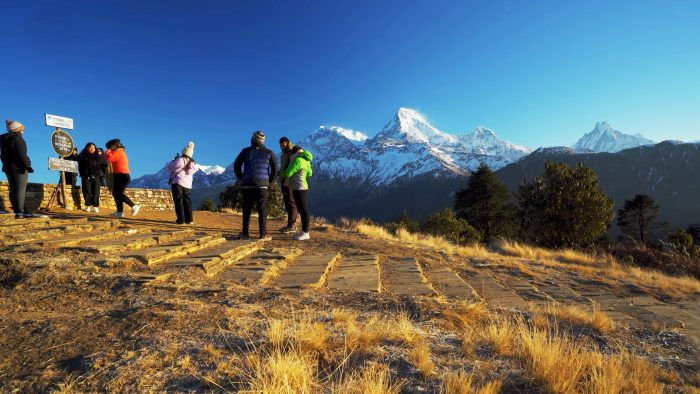
Trip Highlights
Duration: 8 Days
Region: Annapurna
Maximum Elevation: 3,210m
Accommodation: Tea House
Grade: Easy
Restricted Permits: No
Best Seasons: Mar-May, Sep-Nov
The popular Ghorepani Poon Hill trek is one of the classic short treks in Nepal. Ghorepani Poon Hill Trek is also known as Poon Hill Trek. It is also the Best Short and Easy Trek in the Annapurna region. This trek in the Annapurna region is one of Nepal’s favorite short and easy treks for novice trekkers. Embracing the best Himalayan travel experience in less time and effort, this trekking package has attracted many trekkers.
Poon Hill offers panoramic views of Nepal’s most famous peaks – Dhaulagiri, Nilgiri, Hiunchuli, Machhapuchhre, Annapurna I, and Annapurna South. The Annapurna region is one of Nepal’s most beautiful trekking regions where you can enjoy the remarkable natural beauty. On this trip, you will observe Gurung and Magar settlements with many temples and monasteries. You can observe the local traditions, culture, and customs of the people in these villages.
Start Trek
The trek starts from Nayapul, a village near Pokhara. Your journey will continue through beautiful forests full of rhododendrons and various picturesque villages. The main attraction of the Ghorepani Poon Hill trek is Poon Hill itself. Poon Hill is a famous place for sunrise views. The view of sunrise from Poon Hill with huge snow-capped mountains is amazing.
This 8-day trip is a good option for trekkers who want to spend a short vacation in Nepal and walk through the beautiful countryside with beautiful mountain scenery. This trek is suitable for trekkers and adventure seekers of all ages. You do not need any previous trekking experience as the trekking is low altitude and easy.
Itinerary
1st Day: Drive Kathmandu to Pokhara (820m) – 7 to 8 hours.
2nd Day: Drive Pokhara to Nayapul (2 hours) and start trek to Ulleri (1,960m) – a 5 to 6 hours walk.
3rd Day: Ulleri to Ghorepani (2,750m) – 4 to 5 hours walk.
4th Day: Morning Excursion to Poon Hill (3,210m) and trek to Tadapani (2,510m) – 7 to 8 hours walk.
5th Day: Tadapani to Ghandruk (1,950m) – 4 to 5 hours walk.
6th Day: Ghandruk to Pothana (1,990m) – 6 to 7 hours walk.
7th Day: Pothana to Phedi (3 to 4 hours walk) and drive to Pokhara (30 minutes)
8th Day: Drive Pokhara to Kathmandu – 7 to 8 hours.
5. Manaslu Trek
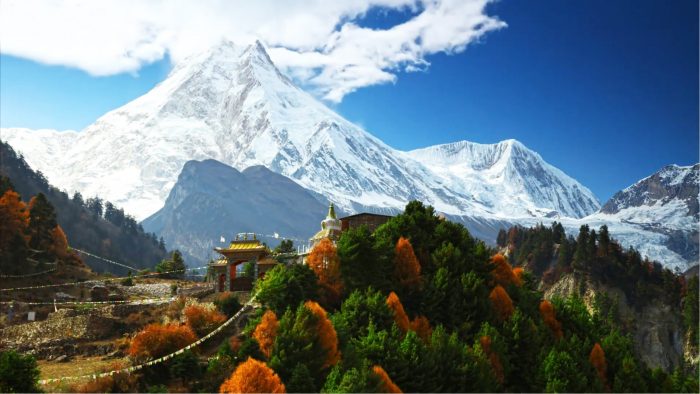
Trip Highlights
Duration: 15 Days
Region: Annapurna, Manaslu
Maximum Elevation: 5,160m
Accommodation: Tea House
Grade: Moderate to Strenuous
Restricted Permits: Yes
Best Seasons: Mar-May, Sep-Nov
Manaslu Trek is one of the 10 best treks in Nepal. The 15-day Manaslu trek circumnavigates Mount Manaslu (8,163m). This trek takes you to the Manaslu Conservation Area and offers a magnificent view of the eighth-highest mountain in the world (Mt. Manaslu). Manaslu Trek was opened only in 1992 and it quickly became popular among trekkers due to its breathtaking scenery, uniqueness, and untouched beauty.
Manaslu Trek in Nepal is an adventurous and enjoyable complete trekking package that offers a great opportunity to explore the local lifestyle and culture. This trip is a unique combination of scenic views of snow-capped mountains, rich cultural heritage, and rare biodiversity. It is a moderate to strenuous trek that takes you to the maximum height of 5,160 meters of Larkya La Pass.
Manaslu Trek covers Manaslu Conservation Area as well as Annapurna Conservation Area. This trip takes you to the north side of Nepal near the China border to the scenic Himalayan region. Allowing you to experience the culture and lifestyle of both Hindus and Buddhists, these trekking trails take you through rich forests full of rhododendron, pine, juniper trees, and lush grasslands. During the trek, you will cross high and long suspension bridges.
The main attraction of this Manaslu trek is not only the natural beauty, this trek also attracts the Tibetan culture. Manaslu conservation area is a sanctuary for different types of birds and animals where endangered wild animals like gray musk deer, Himalayan Thar snow leopard, blue sheep, and red panda are protected.
Start Trek
The Manaslu trek starts with a scenic 9 to 10-hour drive from Kathmandu to Soti Khola. The next morning you will cross beautiful forests, cliffs, terraced areas, and suspension bridges to reach the Machha Khola. On the third day, the journey takes you to Jagat and on the fourth day to Deng.
The view of impressive waterfalls and suspension bridges on the way to Deng is spectacular. Deng is a beautiful Buddhist village with holy monasteries and rivers. From Deng, you will pass Prok and Lihi villages to reach Samagaon village. After reaching Samgaon, you can see the beautiful view of many mountains including Manaslu.
From Samagaon you will hike to Manaslu base camp the next morning and return to Samagaon. The highlight of this trek is the Larkya La Pass (5,160m) which is also the highest elevation of the trek. While crossing Larkya La pass you will see Mani walls, prayer flags, and the beautiful sight of Larkya glacier which will add excitement to your journey.
Teahouses are available for accommodation and food along the trekking trail. This is a tea house trekking but you can also complete this trek by camping. This trip covers the Manaslu and Annapurna regions so both Annapurna Conservation Area Project (ACAP) and Manaslu Conservation Area Project (MCAP) permits are required. As this is a restricted trekking area, the trek requires a special permit from the Government of Nepal and requires at least two people.
Itinerary
1st Day: Drive Kathmandu to Soti Khola (710m) – 9 to 10 hours.
2nd Day: Soti Khola to Maccha Khola (900m) – 6 to 7 hours walk.
3rd Day: Maccha Khola to Jagat (1,410m) – 7 to 8 hours walk.
4th Day: Jagat to Deng (1,840m) – 7 to 8 hours walk.
5th Day: Deng to Prok (2,397m) – 8 to 9 hours walk.
6th Day: Prok to Lihi (2,920m) – 6 to 7 hours walk.
7th Day: Excursion to Hinang Glacier and continue trek to Lho (3,180m) – 7 to 8 hours walk.
8th Day: Lho to Samagaon (3,520m) via Pung Gyen Gompa – 6 to 7 hours walk.
9th Day: Day hike to Manaslu Base Camp (4,400m) and back to Samagaon – 7 to 8 hours walk.
10th Day: Samagaon to Samdo (3,875m) – 4 to 5 hours walk.
11th Day: Samdo to Dharmsala (4,460m) – 5 to 6 hours walk.
12th Day: Dharmsala to Bhimthang (3,590m) via Larky La Pass (5,160m) – 9 to 10 hours walk.
13th Day: Bhimthang to Tilije (2,300m) – 7 to 8 hours walk.
14th Day: Tilije to Syange (1,100m) – 6 to 7 hours walk.
15th Day: Drive Syange to Kathmandu – 8 to 9 hours.
6. Upper Mustang Trek
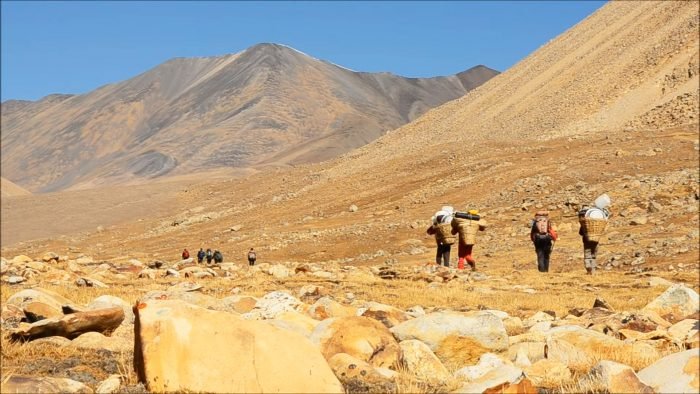
Trip Highlights
Duration: 16 Days
Region: Mustang
Maximum Elevation: 4,960m
Accommodation: Tea House
Grade: Moderate
Restricted Permits: Yes
Best Seasons: Mar-May, Sep-Nov
Upper Mustang trek is another one of the lists of the top 10 best treks in Nepal. This Trek is one of the most remarkable, adventurous, and scenic treks in the Mustang region of Nepal. Upper Mustang is a valley in the rain shadow region of the northern Himalayas of Nepal. As this region is located in the rain shadow of the Himalayas, its geography is different from other parts of Nepal.
There is less rainfall so the land here is dry and barren. In this dry place, there is no vegetation other than a few plants. You can trek in the upper Mustang region even during the rainy season as there is very little rainfall. In this area, you will find many gompas, prayer flags, and monasteries which are evidence of the prevailing Tibetan Buddhist culture.
This valley was a forbidden kingdom within Nepal in the past. This kingdom has been isolated from the world for decades and developed traditions and culture that are closely related to Tibetan culture. Currently, Upper Mustang has become a major trekking destination in Nepal due to its unique desert-like terrain, history, and culture.
Journey to Mysterious Place
Upper Mustang trekking is a journey to mysterious places that will make you feel like a treasure hunt. It is also a journey to a place far from modernization where you will experience a similar civilization to earlier times. So, if you love adventure and want to explore the centuries-old lifestyle now, Upper Mustang Trekking is a perfect option.
The region is rich in historical and religious heritage. Geographically it is a part of the Tibetan Plateau so its culture and traditions are more similar to Tibetan than Nepali. The Upper Mustang area was only opened for trekking and tours in 1992. Ancient caves, sacred fossilized rocks, arid land, and cliffs can be found in Upper Mustang.
The ancient capital of Upper Mustang is Lo Manthang. Lo Manthang is a small town of about 150 houses where you can visit a monastery called Lakhang which is about 200 years old. Mustang is in the Annapurna Conservation Area so during this trek you can enjoy panoramic views of the mountains Dhaulagiri (8,167m), Annapurna (8,091m), and Manaslu (8,163m) higher than 8000 m.
Teahouses can be found on the upper Mustang routes where food and accommodation are available for trekkers. As this area is restricted, a special trekking permit must be taken through the Nepal Trekking Agency registered by the Nepal Government for trekking. And according to Nepal government rules, at least 2 people are required for this trek.
Itinerary
1st Day: Drive Kathmandu to Pokhara – 7 to 8 hours.
2nd Day: Fly Pokhara to Jomsom (20 minutes) and trek to Kagbeni (2,810m) – 3 to 4 hours walk.
3rd Day: Kagbeni to Chele (3,562m) – 6 to 7 hours walk.
4th Day: Chele to Syangbochen (3,800m) – 6 to 7 hours walk.
5th Day: Syanbochen to Ghami (3,520m) – 6 to 7 hours walk.
6th Day: Ghami to Lo Tsarang (3,960m) – 5 to 6 hours walk.
7th Day: Tsarang to Lo Manthang (3,810m) – 4 to 5 hours walk.
8th Day: Explore the eastern valley at Lo Manthang
9th Day: Day trip to Nyamdo at Lo-Manthang.
10th Day: Lo Manthang to Dhi (3,400m) – 6 to 7 hours walk.
11th Day: Dhi to Tangyee (3,340m) – 6 to 7 hours walk.
12th Day: Tange to Tentang (3,040m) – 7 to 8 hours walk.
13th Day: Tentang to Muktinath (3,800m) – 6 to 7 hours walk.
14th Day: Muktinath to Jomsom (2,720m) – 5 to 6 hours walk.
15th Day: Fly Jomsom to Pokhara (20 minutes)
16th Day: Fly Pokhara to Kathmandu (30 minutes).
7. Langtang Valley Trek
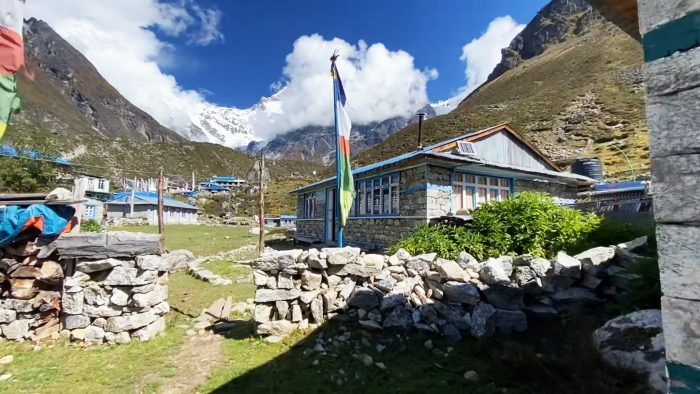
Trip Highlights
Duration: 9 Days
Region: Langtang
Maximum Elevation: 3,900m
Accommodation: Tea House
Grade: Moderate
Restricted Permits: No
Best Seasons: Mar-May, Sep-Nov
Langtang Valley is located in the Langtang region of Nepal. The Langtang Valley Trek is one of the most popular and best treks in the Langtang region of Nepal. This trek is the most hidden trek destination in Nepal which is located around 51 km north of Kathmandu. Langtang is a glacially rich valley with more than 70 glaciers.
Langtang Valley is surrounded by the beautiful mountain peaks of Langtang Ri, Dorje Lakpa, Langtang Himal, and Langshisa Ri. This nine-day trekking package takes you to the wilderness of beauty and describes the beauty of the Himalayas, the unique biodiversity, and the Tibetan way of life. Crystalline lakes and tranquil glaciers are a delight along the trail.
Langtang Valley is also rich in culture, tradition, and diversity. The Tamang people are the ancient and prominent inhabitants of the Langtang Valley. Apart from Tamang, Newari and Sherpa tribes also live here. The religious customs, language, and dress of the people of this area are similar to those of Tibet. The Langtang trek is a great option for those who want to take a short trip from Kathmandu to the Himalayas, influenced by the Tibetan way of life.
Rhododendrons, majestic waterfalls, bamboo forests, snow-capped mountains, and hair-raising landscapes will captivate you. The beautiful glacier lakes, green vegetation, Tamang people, and their unique lifestyle impress all the trekkers. While hiking around the Langtang Valley, you will climb small peaks and visit beautiful glaciers at a comfortable low altitude. Langtang Valley trek is a great option for both nature lovers and adventure seekers in Nepal’s Himalayas.
Start Trek
The journey begins with a drive from Kathmandu to Syaphru Besi. An 8 to 9-hour drive by jeep will take you to Syaphru Besi. The next day your trek starts from Syaphru Besi to Lama Hotel. From Lama Hotel the next day your main destination will be Langtang Valley where you will be warmly welcomed by the local Tamangs. The next day you will trek to Kyagnjin Gompa, where you will spend one more day acclimatizing.
On acclimatization day, you can explore local monasteries, visit a cheese factory, and hike to Tserko Ri (5,450m) viewpoint. From this viewpoint point, you will have a panoramic view of the glacier as well as majestic mountains like Langtang Lirung (7,234m), Langtang II (6,586m), Naya Khang (5,844m), and Yala Peak (5,520m). From Kyagnjin Gompa, you will return by the same route.
This is a moderate hike that is suitable for any level of hiking enthusiast. No previous trekking experience is required for the Langtang trek. A physically fit person of any age group can complete this trip. There are teahouses available for food and accommodation along the trekking routes. TIMS (Trekkers’ Information Management System) and Langtang Conservation Area Permit are mandatory for this area.
Itinerary
1st Day: Drive Kathmandu to Syaphru Besi (1,500m) – 8 to 9 hours.
2nd Day: Syaphru Besi to Lama Hotel (2,480m) – 6 to 7 hours walk.
3rd Day: Lama Hotel to Langtang Village (3,541m) – 6 to 7 hours walk.
4th Day: Langtang to Kyangjin Gompa (3,900m) – 4 to 5 hours walk.
5th Day: Acclimatization day at Kyangjin Gompa.
6th Day: Kyangjin Gompa to Langtang Village (3,541m) – 3 to 4 hours walk.
7th Day: Langtang Village to Lama Hotel (2,480m) – 6 to 7 hours walk.
8th Day: Lama Hotel to Syaphru Besi via Sherpa Gaun (3,000m) and Khangjung – 6 to 7 hours walk.
9th Day: Drive Syaphru Besi to Kathmandu – 8 to 9 hours.
8. Chisapani Nagarkot Trek
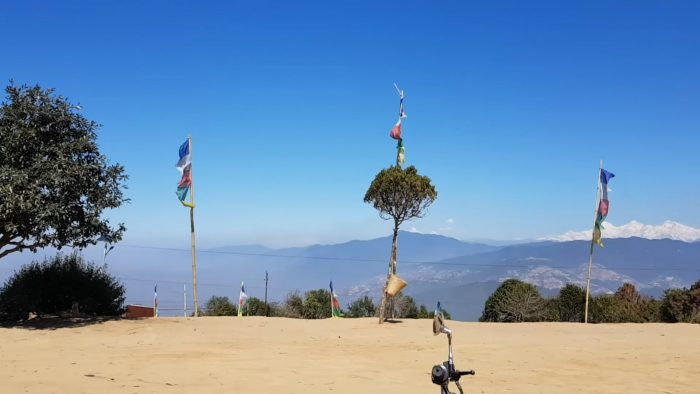
Trip Highlights
Duration: 6 Days
Region: Kathmandu Valley
Maximum Elevation: 2,215m
Accommodation: Tea House / Lodge
Grade: Easy
Restricted Permits: No
Best Seasons: Mar-May, Sep-Nov
Chisapani Nagarkot trek is the nearest and most famous trek near Kathmandu. Chisapani Nagarkot is a short and easy trek in the Kathmandu Valley which is a combination of unique life hood, ethnic culture, and mountain scenery. In this trekking, you can enjoy the Himalayan scenery as well as the diversity of nature at a distance of 32 km from Kathmandu city. Most of the trails you follow on this Chisapani Nagarkot trek pass through the forest where dozens of different wildlife can be found.
Being an easy trip, it is suitable for children, families, students, and those who want to spend a short time in Nepal and explore the rural lifestyle. This trek is a great experience to get away from the hustle and bustle of city life and interact with the local people. This trekking trail is full of green fields and settlements. The people of this area are still mostly farmers and follow a traditional way of life. Walking in the hills surrounding the Kathmandu Valley is also a great option to explore the differences between urban and rural areas.
Start Trek
You can drive an hour from Kathmandu to reach Sundarijal from where the trekking will start. After 5 to 6 hours of walking, you will reach the beautiful ancient settlement of Chisapani at an altitude of 2,215 meters where you will experience the true natural beauty away from the busy and crowded city. During Chisapani’s stay, you will get the opportunity to interact with the local people of the village and learn about their rural lifestyle.
Another beautiful and famous place is Nagarkot which you can reach from Chisapani by a 6 to 7-hour walk. Nagarkot is a great destination to experience true nature with spectacular sunrise and sunset views. On a clear day, you can see a panoramic view of Ganesh Himal, Gaurishankar, Dorje Lakpa, Langtang, and other mountains from Nagarkot.
The next day after a 6 to 7-hour walk you will reach Dhulikhel which is an ancient small town inhabited by the Newar community. Namobuddha is another important destination which is also a holy place for Buddhists with a large Buddhist monastery. Popular among Buddhists, this beautiful monastery is located on top of a hill. From here you can enjoy 360-degree views of the valley below which makes it a popular tourist destination. The next day you will return to Kathmandu via Balthali village.
For those looking for a short and easy trek in Nepal, this 6-day Chisapani Nagarkot trek is perfect. It is also a great option for those who cannot undertake difficult treks in remote areas. It is on the list of 10 best treks in Nepal as it can be completed by anyone regardless of age and fitness level with a short and easy trek.
Itinerary
1st Day: Drive Sundarijal (1 hour) and trek to Chisapani – 5 to 6 hours walk.
2nd Day: Chisapani to Nagarkot – 6 to 7 hours walk.
3rd Day: Nagarkot to Dhulikhel – 6 to 7 hours walk.
4th Day: Dhulikhel to Namabuddha – 3 to 4 hours walk.
5th Day: Namobuddha to Balthali – 5 to 6 hours walk.
6th Day: Balthali to Khopasi (an hour’s walk.) and drive to Kathmandu (2 – 3 hours).
9. Upper Dolpo Trek
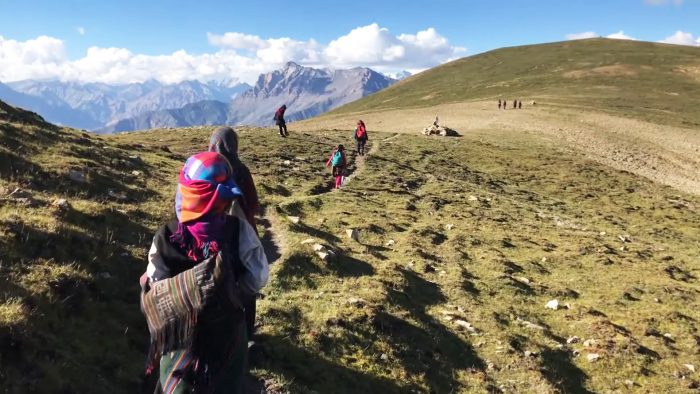
Trip Highlights
Duration: 22 Days
Region: Dolpo
Maximum Elevation: 5,375m
Accommodation: Lodge/Camping
Grade: Strenuous
Restricted Permits: Yes
Best Seasons: Mar-May, Sep-Nov
Upper Dolpo Trek is the perfect choice for trekkers looking for off-the-beaten-path and remote area trekking in Nepal. Even if you love adventure and isolated trekking, this is a suitable trek that will take you to remote areas of Nepal’s unique beauty. Upper Dolpo is a remote and protected area near Nepal’s Tibetan border that has remained the same for centuries. This trek will take you to a place where the terrain separates people from the outside world. Even though it is a remote area, you will not find better hospitality than here anywhere in Nepal.
Find Endangered Species in National Park
Upper Dolpo trek takes you to Shey Phoksundo National Park, where you will find endangered species like snow leopard, gray wolf, musk deer, blue sheep, goral, great Tibetan sheep, Himalayan tahr, wild dog, wolf, jackal, Himalayan black bear, etc.
The Upper Dolpo trek is beautiful for its natural splendor and biodiversity as well as unique cultural and social aspects. The people of this region practice Tibetan Buddhism which is reflected in their daily life. The customs and traditions of the people here are similar to the Tibetan people. It is a remote, peaceful, and wilderness journey where the local lifestyle is untouched by modernity.
Entry to foreigners was prohibited until a few decades ago but has now been opened up and special permits are required to enter this restricted area. Opened to foreigners only in 1992, it is a trekking destination in a remote area of Nepal that few people have visited.
The main attraction of this trekking is the Phoksundo Lake inside the Phoksundo National Park. Surrounded by beautiful forests and snow-capped peaks, the lake has been described as a natural hidden wonder of the world. Known as the spiritual center of Upper Dolpo, Shay Gompa is a beautiful monastery located on the base of Crystal Mountain. Many pilgrims visit this monastery every year.
Start Trek
The main starting point for the Dolpo trek is Jhuphal which can be accessed by a flight from Kathmandu to Nepalgunj and then another flight from Nepalgunj to Juphal. Trekking begins in tropical forests with pine trees. The trail takes you to Phoksundo Lake, Nepal’s deepest lake with blue water. You can explore Bon Po culture in nearby villages and visit monasteries.
Compared to other treks, this trek is a bit expensive as teahouses, hotels and lodges are not available on this trekking route. Apart from Kathmandu, Nepalganj, and Juphal, tents should be camped in all other places. Upper Dolpo trek is a difficult level trek and during the trek, you have to trek for 6-7 hours of steep hilly terrain and sometimes cross high passes up to 5,000 meters. So technical skills are not required but previous trekking experience, physical fitness, and a positive attitude are essential.
Itinerary
1st Day: Fly Kathmandu to Nepalgunj – 1 hour.
2nd Day: Fly Nepalgunj to Juphal (2,475m) and trek to Chhepka (2,838m) – 6 to 7 hours walk.
3rd Day: Chhepka to Chunuwar (3,110m) – 6 to 7 hours walk.
4th Day: Chunuwar to Ringmo/Phoksundo Lake (3,733m) – 3 to 4 hours walk.
5th Day: Free Day at Ringmo/Phoksundo Lake.
6th Day: Ringmo/Phoksundo Lake to Chunemba (3,639m) – 5 to 6 hours walk.
7th Day: Chunemba to Snowfields Camp (4,400m) – 7 to 8 hours walk.
8th Day: Snowfields to Shey Gompa (4,310m) via Kang La (5,375m) – 6 to 7 hours walk.
9th Day: Free Day at Shey Gompa.
10th Day: Shey Gompa to Namgung (4,430m) – 3 to 4 hours walk.
11th Day: Namgung to Saldang (4,060m) – 3 to 4 hours walk.
12th Day: Saldang to Sibu (4,200m) – 5 to 6 hours walk.
13th Day: Sibu to Lagmo Che (4,570m) – 4 to 5 hours walk.
14th Day: Lagmo Che to Tokyu (4,209m) via Jeng La Pass (5,110m) – 7 to 8 hours walk.
15th Day: Tokyu to Dho Tarap (4,080m) – 2 to 3 hours walk.
16th Day: Dho Tarap to Sisaul (3,750m) – 4 to 5 hours walk.
17th Day: Sisaul to Laina Odar (3,370m) – 8 to 9 hours walk.
18th Day: Laina Odar to Lingdo (2,391m) – 5 to 6 hours walk.
19th Day: Lingdo to Dunai (2,140m) – 5 to 6 hours walk.
20th Day: Dunai to Juphal (2,475m) – 4 to 5 hours walk.
21st Day: Fly Juphal to Nepalgunj – 35 minutes.
22nd Day: Nepalgunj to Kathmandu – 1 hour.
10. Kanchenjunga Trek
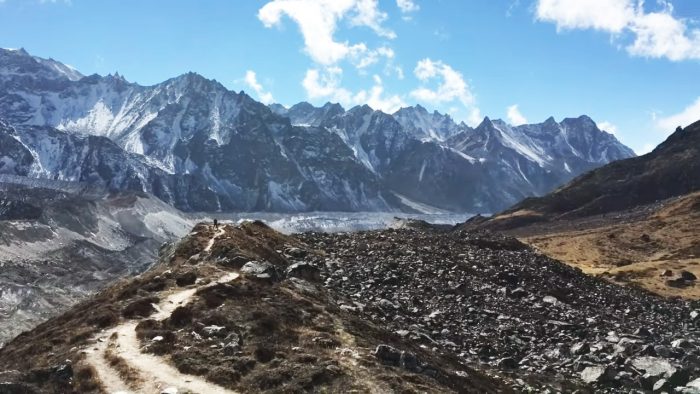
Trip Highlights
Duration: 22 Days
Region: Kanchenjunga
Maximum Elevation: 5,143m
Accommodation: Tea house
Grade: Moderate/Strenuous
Restricted Permits: Yes
Best Seasons: Mar-May, Sep-Nov
On the list of 10 Best Treks in Nepal Kanchenjunga Trek is a beautiful trek. This trek takes you to the lap of Kanchenjunga (8,586m), the second-highest mountain in Nepal and the third-highest mountain in the world. For people who love trekking in remote areas and off the beaten trail, the Kanchenjunga trek is a good option. Its remoteness attracts only those travelers who prefer to stay away from the crowds, enjoy solitude, to walk off the beaten path. The Kanchenjunga base camp area has innumerable beauties with its diverse geography.
Starting at 920 meters and reaching a height of 5,143 meters above sea level, this trek is an exciting and challenging journey. This is an amazing trekking experience in the Himalayan region of Nepal. Explore the unspoiled natural beauty of the Kanchenjunga area. This area is mainly inhabited by Rai and Limbu ethnic groups. These ethnic groups have their own culture, tradition, and lifestyle. People in this area mostly practice Tibetan Buddhist culture so you can find monasteries, stupas, and gompas along the way.
Kanchenjunga is located in the far eastern part of Nepal, bordering the small Himalayan state of Sikkim in the northeastern part of India. Kanchenjunga Base Camp Trekking is a wilderness and unspoiled trekking trail that was opened for trekking to foreigners only in 1988.
View of Beautiful Mountains
On the way, you will find rivers, waterfalls, green fields, rhododendron forests, etc. This area is protected by the Kanchenjunga Conservation Area. In this protected area, you can find blue sheep, Himalayan Thar, Himalayan birds, Daphne, Monal, etc. This 22-day trek offers panoramic views of Kanchenjunga (8,586m), Jannu (7,710m), Sobithongi (6,670m), Kabru (7,353m), Tent Peak (7,365m), Twins (7,350m), etc. mountains.
The Kanchenjunga trek is a moderate to strenuous hike of a long duration. The trail has frequent ups and downs and some trails are very steep and risky so the trek is not easy. Some days you have to walk for 7 to 8 hours at an altitude above 4,000 meters and for this, you need a fit body and a healthy mind. Trekkers often feel tired in the middle of the trek while trekking in the high Himalayas for long days. So, it is important to be mentally and physically prepared before going for Kanchenjunga trekking.
A special trekking permit is required for trekking in this area as it is a restricted area. According to the rules, a minimum of 2 people are required to obtain a special trekking permit. The Kanchenjunga area is isolated and remote so trekkers rarely visit the area and the tourist infrastructure is very less compared to other treks. Normal teahouses are available on these trekking trails but you can also do a camping trek to get an amazing experience in the Himalayas of Nepal.
Itinerary
1st Day: Fly Kathmandu to Taplejung (2,320m) and trek to Mitlung (9,20m) – a 3 to 4 hours walk.
2nd Day: Mitlung to Chirwa (1,270m) – 6 to 7 hours walk.
3rd Day: Chirwa to Sukathum (1,576m) – 6 to 7 hours walk.
4th Day: Sukathum to Amjilosa (2,308m) – 7 to 8 hous walk.
5th Day: Amjilosa to Gyabla (2,730m) – 7 to 8 hours walk.
6th Day: Gyabla to Ghunsa (3,595m) – 6 to 7 hours walk.
7th Day: Free day at Ghunsa.
8th Day: Ghunsa to Kambachen (4,050m) – 6 to 7 hours walk.
9th Day: Acclimatization Day at Kambachen.
10th Day: Kambachen to Lhonak (4,780m) – 7 to 8 hours walk.
11th Day: Lhonak to Pangpema/Kanchenjunga North Base Camp (5,143m) – 7 to 8 hours walk.
12th Day: Kanchenjunga North Base Camp to Kambachen (4,050m) – 7 to 8 hours walk.
13th Day: Kambachen to Ghunsa (3,595m) – 6 to 7 hours walk.
14th Day: Ghunsa to Sele Le (4,290m) – 7 to 8 hours walk.
15th Day: Sele Le to Cheram (3,870m) – 7 to 8 hours walk.
16th Day: Cheram to Ramche (4,580m) and return to Cheram – 5 to 6 hours walk.
17th Day: Cheram to Tortong (2,995m) – 6 to 7 hours walk.
18th Day: Tortong to Yamphudin (2,080m) – 7 to 8 hours walk.
19th Day: Yamphudin to Mamanke (1,800m) – 7 to 8 hours walk.
20th Day: Mamanke to Lalikharka (2,265m) – 5 to 6 hours walk.
21st Day: Lalikharka to Suketar (2,320m) – 5 to 6 hours walk.
22nd Day: Fly Suketar to Kathmandu.
Accommodation During Best Treks in Nepal
Apart from the upper Dolpo trek, all the above-mentioned 10 best treks in Nepal have teahouses, guesthouses, and lodges available. On the upper Dolpo trek, you have to make arrangements for food and accommodation. The Upper Dolpo trek is also more expensive than other treks as it is a camping trek. Apart from Upper Dolpo, some trekking routes have comfortable accommodations with good facilities while some are basic. However, basic teahouses are available on most routes.
A teahouse is a type of small lodge with simple rooms with beds, pillows, mattresses, and blankets. If you get too cold you can get extra blankets or you can use your sleeping bag. These teahouses are run by locals to provide food and accommodation to the trekkers.
In these teahouses, you can get local Nepali food as well as continental food. Generally, most of the teahouses have rice, noodles, chocolate, eggs, biscuits, soft drinks, cereals, bread, etc. There are not only simple teahouses but also luxurious hotels in some places. So, if your budget is high, you can use the available luxury hotels.
Best Seasons for Best Treks in Nepal
Weather is one of the most important aspects to consider while trekking in the Himalayas of Nepal. If you come to Nepal for trekking when the weather is not good, you will have to face many difficulties. So, you should choose the best season for Nepal trekking. Spring and autumn are considered to be the best seasons for trekking in Nepal.
Since the weather is clear in the spring and autumn seasons, you can see a clear view of the mountains and the surroundings. Spring season includes March, April, and May. As spring begins after winter, the beginning is a bit cold and gradually warms up. The weather in spring is stable which creates favorable conditions for treks in the high mountain regions. As it is the flowering season, the trekking route is beautiful and pleasant during this season. Therefore, the spring season is considered to be the best time to visit Nepal.
Autumn includes September, October, and November. At this time, summer is over and winter has not started, so autumn is the most popular and best trekking season in Nepal. After the monsoon ends, the weather clears, the forest looks natural and the scenery is breathtaking. Autumn in Nepal is often the best and least risky time for any trekking and adventure activity.
Summer is the monsoon season during which the weather is hot and humid resulting in heavy rainfall. Rain often makes trips difficult, so it is not a good time for trekking. Winter in Nepal brings cold, dry weather and snow in the mountains. During this time, it is very cold and high snowfall in the high Himalayan region so trekking at a height above 4,000 is difficult. So, summer and winter are not considered good times for trekking in Nepal.
Conclusion
In conclusion, out of the four seasons, spring and autumn are the best trekking seasons in Nepal. So, you can plan your Nepal trekking trip during the spring and autumn seasons.
Altitude Sickness and Acclimatization During Best Treks in Nepal
Altitude sickness is one of the major problems that can occur while trekking in high mountains. Therefore, it is necessary to be very careful about altitude sickness while trekking in high mountains. Altitude sickness is common when trekking in high mountains. If you ignore it, it can cause serious problems. But by taking some precautions you can easily avoid this problem. Symptoms of altitude sickness can vary from person to person. Its symptoms are usually headache, nausea, dizziness, fatigue, etc.
At altitudes above 3,500 meters, there is less oxygen so the body needs more time to adjust to the outside atmosphere. It is therefore essential to include acclimatization days in your Trekking schedule as this is an important means of preventing altitude sickness. Walking uphill requires acclimating yourself to certain places. If you are well-acclimated to low altitude, you will find trekking easy.
If symptoms of altitude sickness appear, ascend slowly. Drink plenty of liquid, and avoid smoking and alcohol to avoid altitude sickness. Consuming garlic also helps prevent altitude sickness.
Visit Also: Top 10 Reasons Why a Trip to Nepal Should Be on Your Bucket List
Agency, Luggage, Guide, and Porters for Best Treks in Nepal
There is no need to trek with guides and porters through any agency while trekking in the normal areas of Nepal. Without local agencies, guides, and porters, you can trek in normal trekking areas. But for trekking in a restricted area, you have to do trekking through a local trekking company in Nepal. Also, the guide and porter provided by the same company should be used.
However, it is a wise decision to trek with a guide and porter while trekking in any area. Guides are trained professionals who know the trekking trail better than anyone else. With them, you can explore the places better. Trekking with a local company is a safer option as it is the responsibility of the company and the guides to avoid any accidents.
You may not have a lot of luggage for a short trip, but a long trip usually has a lot of luggage. You carry some of your light items like warm clothes, a water bottle, snacks, sunblock, a camera, a towel, soap, a toothbrush, etc. But apart from those light goods, you need porters to carry heavy goods. According to the rules, a porter can carry a maximum weight of 20 kg. If your luggage is more than 20 kg, you can hire additional porters.
Cost for Best Treks in Nepal
The total cost of Nepal trekking depends on the route, trekking agency, service, and many other factors. Teahouse trekking costs less while camping trekking costs more. The cost also depends on the size of the trekking group. The cost will be a bit more expensive if you are single but less if you are in a group. So, to determine the cost, you have to decide which trekking and what kind of service you want to take.
However, the cost can be estimated based on your preferences. If you are doing normal budget trekking then you can do it for $100 to $200 per person per day but if you are doing luxury trekking it will cost more. Trekking in Nepal costs much less than going on a beach vacation. Compared to most countries in the world, the cost of food and accommodation in Nepal is very low. So, trekking in Nepal during vacation is an affordable option.
Also visit: 5 short and easy treks in Nepal

